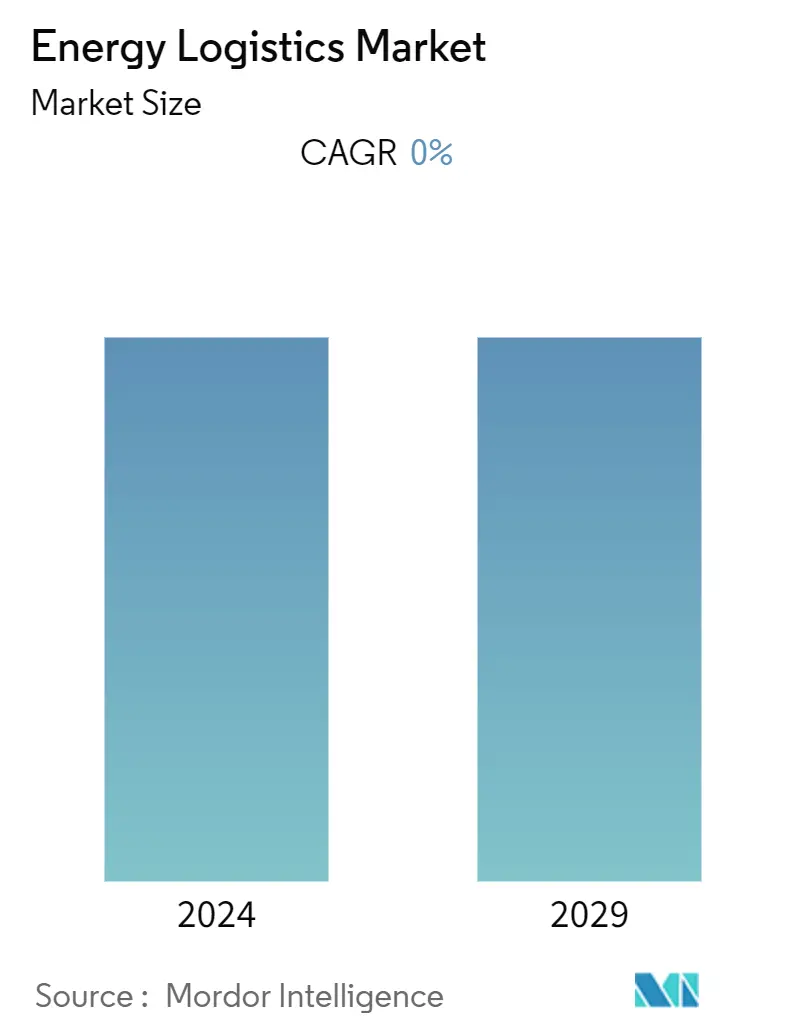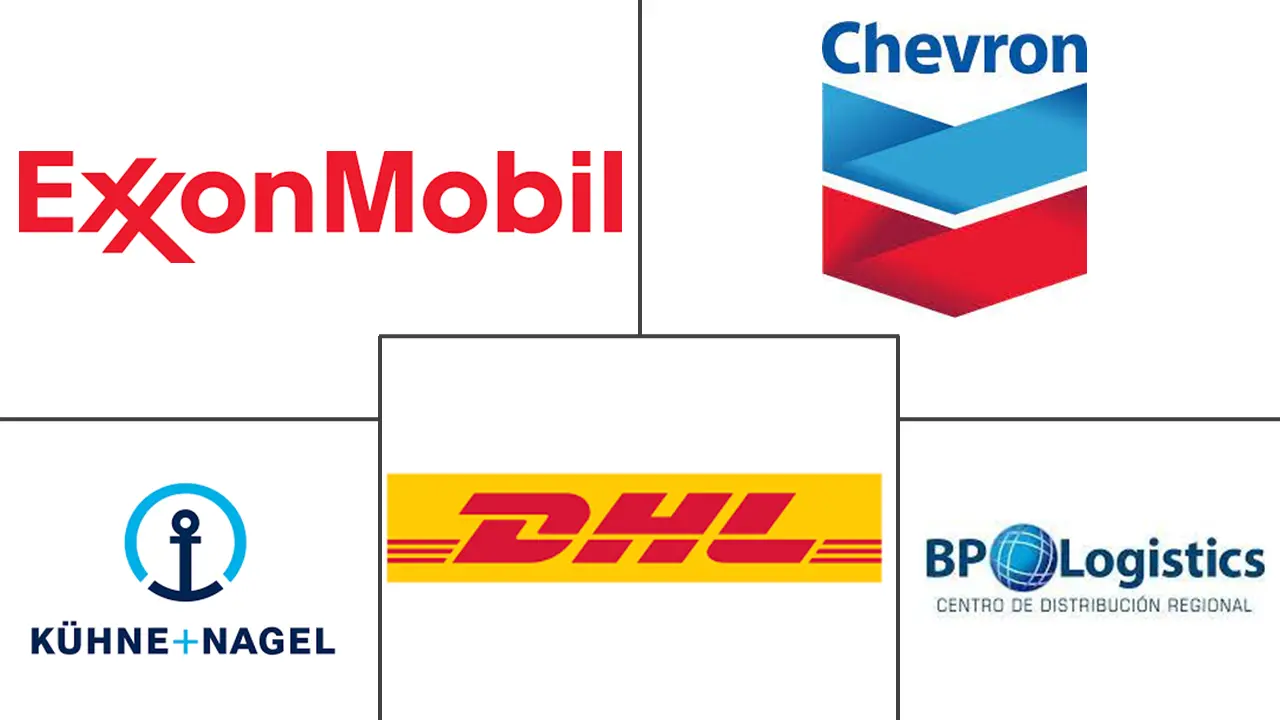Market Size of Energy Logistics Industry

| Study Period | 2019 - 2029 |
| Base Year For Estimation | 2023 |
| Forecast Data Period | 2024 - 2029 |
| CAGR (2024 - 2029) | 0.00 % |
| Fastest Growing Market | Asia Pacific |
| Largest Market | Europe |
| Market Concentration | High |
Major Players
*Disclaimer: Major Players sorted in no particular order |
Energy Logistics Market Analysis
The Energy Logistics Market is expected to register a CAGR of 0% during the forecast period.
- According to the International Energy Agency (IEA), the economic outlook is less optimistic than 2021's outlook, with high energy prices, energy security concerns, and reinforced climate policies ending a decade of rapid growth for natural gas; it is projected to grow at a rate of 0.4% annually between now and 2030 compared to 2.3% between 2010 and 2019.
- Oil demand is projected to grow by 0.8% annually to 2030, reaching a peak of around 103 million barrels per day, with EVs and efficiency improvements reducing its demand. Coal is expected to witness a temporary increase in demand from some regions from the energy and industry sectors as natural gas prices rise, but efforts to cut emissions will soon put coal back into decline, ending the decade 9% lower than it is now.
- Renewables, particularly solar photovoltaic and wind, will account for 43% of global electricity generation in 2030 compared to 28% in 2023. The energy crisis is changing the demand trends that have long been in place.
- Industries that were hit hard by global prices are now facing real risks of production rationing. Consumers are re-evaluating their energy consumption patterns in response to higher prices and, in some cases, to emergency demand reduction initiatives.
- While policy responses vary, many are focused on accelerating clean energy investments. This implies an even greater emphasis on renewables in the energy sector and accelerating electrification in industrial processes, cars, and heating.
- As many of the responses to the crisis align with those required to achieve global climate objectives, the energy crisis may turn out to be a defining moment in terms of driving energy security and reducing emissions.
Energy Logistics Industry Segmentation
Energy logistics refers to the movement and distribution of energy resources in the energy sector through the efficient use of labor, infrastructure, and equipment.
The energy logistics market is segmented by application (oil & gas, renewable energy, power generation, and energy mining), by end-user (government sector and private sector), and by mode of transport (railways, airways, roadways, and waterways). The report offers the market size and forecasts for the energy logistics market in value (USD) for the above-mentioned segments.
| By Application | |
| Oil & Gas | |
| Renewable Energy | |
| Power Generation | |
| Energy Mining |
| By End-User | |
| Government Sector | |
| Private Sector |
| By Mode of Transport | |
| Railways | |
| Airways | |
| Roadways | |
| Waterways |
Energy Logistics Market Size Summary
The energy logistics market is experiencing a transformative phase influenced by shifting demand trends and geopolitical factors. The market is characterized by the transportation, storage, and distribution of crucial energy sources such as oil, gas, and renewables. Despite the challenges posed by high energy prices and climate policies, the oil and gas segment remains a significant component, driven by demand from industries like petrochemicals and aviation. However, the market is also witnessing a gradual shift towards renewables, with solar and wind energy expected to play a more substantial role in global electricity generation. This transition is further accelerated by policy responses aimed at enhancing energy security and reducing emissions, aligning with global climate objectives.
The competitive landscape of the energy logistics market is diverse, with major integrated oil companies like ExxonMobil, Chevron, and BP dominating the scene. These companies leverage their extensive infrastructure and logistics divisions to maintain a competitive edge. Recent strategic moves, such as acquisitions by Lubbers Logistics Group and Ebenezer Logistics, highlight the ongoing efforts to enhance supply chain capabilities and expand into renewable energy sectors. As the market evolves, the focus on electrification and clean energy investments is expected to grow, reflecting broader economic and environmental trends. The interplay of market demand, regulatory frameworks, and technological advancements will continue to shape the future of energy logistics.
Energy Logistics Market Size - Table of Contents
-
1. MARKET INSIGHTS
-
1.1 Market Overview
-
1.2 Current Market Scenario
-
1.3 Technological Trends in the Industry
-
1.4 Government Initiatives and Regulations
-
1.5 Insights into the Ecommerce
-
1.6 Value Chain / Supply Chain Analysis
-
1.7 Demand and Supply Analysis
-
1.8 Impact of COVID-19 on the Market
-
-
2. MARKET SEGMENTATION
-
2.1 By Application
-
2.1.1 Oil & Gas
-
2.1.2 Renewable Energy
-
2.1.3 Power Generation
-
2.1.4 Energy Mining
-
-
2.2 By End-User
-
2.2.1 Government Sector
-
2.2.2 Private Sector
-
-
2.3 By Mode of Transport
-
2.3.1 Railways
-
2.3.2 Airways
-
2.3.3 Roadways
-
2.3.4 Waterways
-
-
Energy Logistics Market Size FAQs
What is the current Energy Logistics Market size?
The Energy Logistics Market is projected to register a CAGR of 0% during the forecast period (2025-2030)
Who are the key players in Energy Logistics Market?
ExxonMobil, Chevron, BP, DHL and Kuehne + Nagel are the major companies operating in the Energy Logistics Market.

